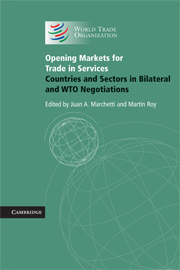Book contents
- Frontmatter
- Contents
- List of figures
- List of tables
- List of boxes
- List of contributors
- Foreword
- Acknowledgments
- Disclaimer
- Summary and overview
- PART I From Policy to Negotiations
- PART II Multilateral and Bilateral Negotiations on Services: Overall Perspectives
- PART III Challenges, Issues and Opportunities in Services Sectors
- 4 Telecommunications: can trade agreements keep up with technology?
- 5 The liberalization of cross-border trade in services: a developing country perspective
- 6 Out of stock or just in time? Doha and the liberalization of distribution services
- 7 Air transport liberalization: a world apart
- 8 Financial services liberalization in the WTO and PTAs
- 9 Beyond the main screen: audiovisual services in PTAs
- 10 The liberalization of postal and courier services: ready for delivery?
- 11 The liberalization of energy services: are PTAs more energetic than the GATS?
- 12 Market access for the government procurement of services: comparing recent PTAs with WTO achievements
- 13 A warmer welcome? Access for natural persons under PTAs
- PART IV Country Experiences with Services Trade
- Index
- References
7 - Air transport liberalization: a world apart
Published online by Cambridge University Press: 05 December 2011
- Frontmatter
- Contents
- List of figures
- List of tables
- List of boxes
- List of contributors
- Foreword
- Acknowledgments
- Disclaimer
- Summary and overview
- PART I From Policy to Negotiations
- PART II Multilateral and Bilateral Negotiations on Services: Overall Perspectives
- PART III Challenges, Issues and Opportunities in Services Sectors
- 4 Telecommunications: can trade agreements keep up with technology?
- 5 The liberalization of cross-border trade in services: a developing country perspective
- 6 Out of stock or just in time? Doha and the liberalization of distribution services
- 7 Air transport liberalization: a world apart
- 8 Financial services liberalization in the WTO and PTAs
- 9 Beyond the main screen: audiovisual services in PTAs
- 10 The liberalization of postal and courier services: ready for delivery?
- 11 The liberalization of energy services: are PTAs more energetic than the GATS?
- 12 Market access for the government procurement of services: comparing recent PTAs with WTO achievements
- 13 A warmer welcome? Access for natural persons under PTAs
- PART IV Country Experiences with Services Trade
- Index
- References
Summary
International air transport has traditionally been the subject of extensive regulatory controls. Imagine a world in which prices, the number of seats, the number of flights, the types of aircraft, and the cities to be served are all decided by agreements between states, in which no third-party competition exists, in which strict national ownership rules are applied, and in which the only unknown parameter for airlines is the number of passengers who will turn up in the end. This is the “Bermuda II” type of agreement, which served as the model for the organization of the post-war international air industry, and whose features, only partially “eroded” over the years, still largely underpin the regulatory framework of the sector.
The so-called “open skies” agreements are a simple relaxation of some of these regulatory constraints on prices, seat capacity, and choice of routes. The framework remains strictly bi-national, however, with strong ownership rules, and only marginal third-party competition via the allocation of fifth freedom rights. Liberalization through “open skies” is therefore, more a “bilateral deregulation” than a liberalization process stricto sensu. In any event, “open skies agreements” cover only about one-sixth of world traffic.
There also exists a third type of air transport liberalization, consisting of a “single market” between several countries (e.g., within the European Communities, or between Australia and New Zealand), in which airlines from the member states are allowed to fly without any market access restrictions to any destination, the role of the state being limited to the enforcement of safety and security regulations.
- Type
- Chapter
- Information
- Opening Markets for Trade in ServicesCountries and Sectors in Bilateral and WTO Negotiations, pp. 264 - 299Publisher: Cambridge University PressPrint publication year: 2009

